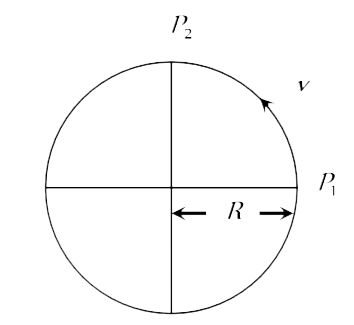A body of mass 1kg is moving with a uniform speed of 1m/s in a circular path of radius 1m. The external force acting on the body is
1N
1 dyne
1J
zero
The correct Answer is:A
To find the external force acting on a body moving in a circular path, we can use the concept of centripetal force. Here’s a step-by-step solution:
Step 1: Identify the parameters
- Mass of the body (m) = 1 kg
- Speed of the body (v) = 1 m/s
- Radius of the circular path (r) = 1 m
Step 2: Understand the concept of centripetal force
When an object moves in a circular path at a constant speed, it experiences a centripetal force directed towards the center of the circular path. This force is necessary to keep the object moving in that circular path.
Step 3: Use the formula for centripetal force
The formula for centripetal force (F_c) is given by:
Fc=mv2r
where:
- m = mass of the body
- v = speed of the body
- r = radius of the circular path
Step 4: Substitute the values into the formula
Now, substituting the values into the formula:
Fc=(1kg)⋅(1m/s)21m
Step 5: Calculate the centripetal force
Calculating the above expression:
Fc=1⋅11=1N
Conclusion
The external force acting on the body is a centripetal force of 1 Newton directed towards the center of the circular path.
---
- Mass of the body (m) = 1 kg
- Speed of the body (v) = 1 m/s
- Radius of the circular path (r) = 1 m
When an object moves in a circular path at a constant speed, it experiences a centripetal force directed towards the center of the circular path. This force is necessary to keep the object moving in that circular path.
The formula for centripetal force (F_c) is given by:
Fc=mv2r
where:
- m = mass of the body
- v = speed of the body
- r = radius of the circular path
Now, substituting the values into the formula:
Fc=(1kg)⋅(1m/s)21m
Calculating the above expression:
Fc=1⋅11=1N
The external force acting on the body is a centripetal force of 1 Newton directed towards the center of the circular path.
Topper's Solved these Questions
- BOOK - PRADEEPCHAPTER - FORCES AND LAWS OF MOTIONEXERCISE - MOCK TEST36videos
FORCES AND LAWS OF MOTION
- BOOK - PRADEEPCHAPTER - FORCES AND LAWS OF MOTIONEXERCISE - ASSESSSMENT THROUGH PAPER-PEN TEST29videos
FORCES AND LAWS OF MOTION
- BOOK - PRADEEPCHAPTER - FLOTATIONEXERCISE - Problem For Practice6videos
FLOTATION
- BOOK - PRADEEPCHAPTER - GRAVITATIONEXERCISE - Model Test paper (1)36videos
GRAVITATION
Similar Questions
A body of mass 5kg is moving along a circle of radius 1m with a uniform speed of 5m/s. The external force acting on the body is
View SolutionIf a body of mass 5 kg is moving in a circle of radius 5 m with a velocity 100 m/s, then the centripetal force acting on the body is 10xN , where the value of x is____.
View Solution
Knowledge Check
- Question 1 - Select One
A body of mass 10 kg moves with a constant speed v of 2 ms−1 along a circular path of radius 8 m. The power produced by the body will be
A10 Js−1B98 Js−1C49 Js−1Dzero - Question 2 - Select One
A body of mass 5kg is moving in a circle of radius 1 m with an angular velocity of 2 rad-s−1. The centripetal force acting on the body is
A10 NB20 NC30 ND40 N - Question 3 - Select One
Figure below shows a body of mass M moving with the uniform speed on a circular path of radius, R. What is the change in acceleration in going from P1 to P2
 AZeroBv2/2RC2v2/RDv2R×√2
AZeroBv2/2RC2v2/RDv2R×√2
A body of mass 5 kg is moving in a circle of radius m 1 with an angular velocity of 2 radian/sec . The centripetal force is
View SolutionA body of mass 10 kg is moving in a circle of radian 1 m with an angular velocity of 2rad/s the centripetal force is
View SolutionA body of mass 1 kg is moving in a vertical circular path of radius 1 m. The difference between the kinetic engeries at the highest and lowest position is
View SolutionA body of mass 1 kg is moving in a vertical circular path of radius 1 m. The difference between the kinetic energies at its highest and lowest position is
View SolutionA body moves with a speed of 2πms−1 in a cirular path of radius 1 m , then the time taken to compete one revolution is ________.
View Solution

